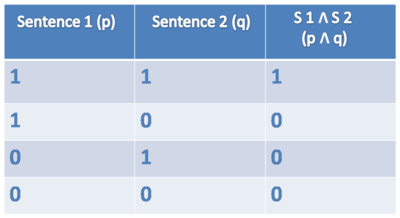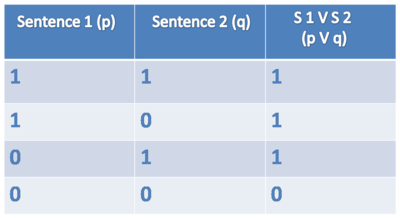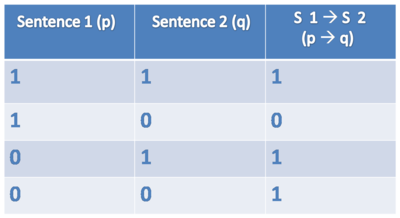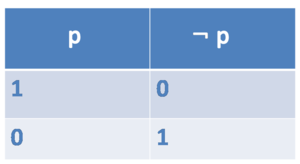Wiki-ch2
Additional Wiki pages for Chapter 2
Models
The following material is an adapted form of material created by student participants of the project e-Learning Resources for Semantics (e-LRS). Involved participants: Lisa, Marthe, Elisabeth, Isabelle.
Watch a short podcast what first-order models look like.
<mediaplayer>http://youtu.be/4a3mXelw7H4</mediaplayer>
Truth tables
The following material is an adapted form of material created by student participants of the project e-Learning Resources for Semantics (e-LRS). Involved participants: Lisa, Marthe, Elisabeth, Isabelle.
Truth tables for connectives
AND (∧)
Symbol: ∧
Sentence: Harry is a student and Snape is a teacher.
Formulae: student(harry) ∧ teacher(snape)
A conjunction p ∧ q it true if and only if p is true and q is true.
Truthtable AND
OR (∨)
Symbol: ∨
Sentence: Harry is a student or Snape is a teacher.
Formulae: student(harry) ∨ teacher(snape)
A disjunction p ∨ q is true if and only if p is true or q is true (or both).
Truthtable OR
IF/THEN (⊃, →)
Symbol: ⊃, → (Note: We use the symbol ⊃ in the textbook as it is more common in the logical literature.)
Sentence: If Harry is a student then Snape is a teacher.
Formula: student(harry) ⊃ teacher(snape)
An implication p ⊃ q is true if and only if p is false or q is true (or both).
In other words: An implication p ⊃ q is true if and only if whenever p is true, q is true as well.
Truthtable IF/THEN
NOT (¬)
Symbol: ¬
Sentence: Harry is not a student.
Formula: ¬student(harry)
A negated formula ¬p is true if and only if p is false.
Example: Only if student(harry) is false, ¬student(harry) is true.
Truthtable NOT
Truth tables for complex formulae
Truth tables are also useful to compute the truth value of complex formulae. This is shown in the following podcast, created by Lisa Günthner.
<mediaplayer>http://www.youtube.com/watch?v=ZWdltj5Mqdc</mediaplayer>



